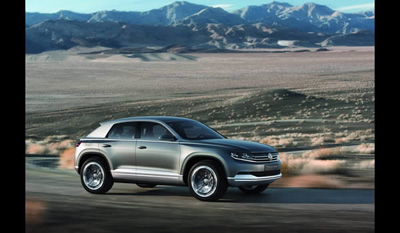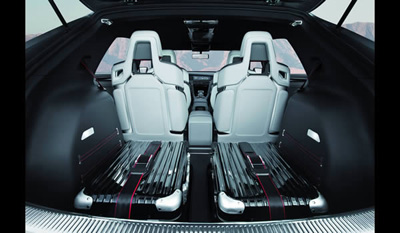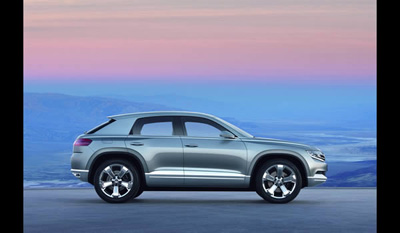Volkswagen Cross Coupe Plug In Hybrid Concept 2011
At the 42nd Tokyo Motor Show Volkswagen introduced a new concept that illustrates the styling of the future SUV (Sports Utility Vehicle). Visually the all-wheel-drive plug-in hybrid
vehicle shows how Volkswagen designers could envisage a crossover between a four-door coupé and a compact SUV. The design team led by Walter de Silva and Klaus Bischoff have created a study that combines the best of two worlds. Original, strong in character, sculptural and dynamic, the Cross Coupé stands for the future of SUV design at Volkswagen.
Technically too the very sporty Cross Coupé concept car defines a new status, being based on Volkswagen’s new modular transverse matrix (MQB) – the first such model ever to be publicly shown. Features of the Cross Coupé consequently include strikingly short bodywork overhangs. The four-seat SUV is powered by two electric motors (40kW at front, 85 kW at rear) and a 110 kW/ 147 hp direct injection turbo petrol engine (TSI). The overall output of the system (petrol engine +battery) is a maximum of 195 kW/ 261 hp. The Cross Coupé can drive a distance of up to 45 kilometres purely on electric power. The all-wheel drive system with ‘electric drive shaft’ represents an innovation for Volkswagen, with the rear axle being driven by the rear of the two electric motors. In this situation power is supplied to the rear electric motor by the one at the front, which during this phase acts as a generator powered by the TSI engine.
In the Cross Coupé the flow of electrical energy thus replaces the conventional transfer of power by means of a drive shaft. And that creates room on board the concept car for another important technology: the centre tunnel, usually the place for the drive shaft, houses the 9,8 kWh lithium ion battery (tunnel battery) on the Cross Coupé. The low position of the battery and the general layout of the drive system give the vehicle a very low centre of gravity and facilitate a balanced spread of axle loading.
At 4,345 mm, the concept car being shown in Tokyo is longer than a Golf and shorter than a Tiguan. The width of 1,868 mm and height of 1,523 mm also come exactly in between
these two bestsellers. In terms of its dimensions the Cross Coupé is therefore a vehicle in the globally much in-demand segment. It is also noticeable that at 2,630 mm the concept car has what in relation to its overall length is a very long wheelbase (52 mm longer than
the Golf and 26 mm longer than the Tiguan). The bodywork overhangs (855 mm at the front and 860 mm at the back) are correspondingly short. All of the dimensions combined, the overall proportions are extremely snappy. The powerful look is underlined by large wheel tracks of 1,585 mm (front) and 1,613 mm (rear).
With a full tank of fuel the Cross Coupé weighs 1,748 kg (58% on the front axle, 42% on the
rear). It can take a further load of 450 kg. In the New European Driving Cycle (NEDC) the TSI engine’s fuel consumption is just 2.7 litres per 100 km, equating to CO2 emissions
of only 62 g/km. With a fuel tank capacity of 55 litres, the theoretical range in hybrid mode is 815 kilometres. Adding in the electric range, the Cross Coupé can do 855 km without stopping for fuel.
Despite the focus on sustainability the concept car being shown in Tokyo is still sporty. The Cross Coupé accelerates from 0 to 100 km/h in just 7 seconds and has a top speed of
201 km/h. If forward propulsion is being provided solely by the electric motors, the top speed is regulated down to 120 km/h. Both the electric motors help (boost) the petrol engine (TSI) during acceleration. As mentioned above, however, they can also power the concept car on its own for a distance of up to 45 kilometres, depending on conditions. Here, by opening the
clutch, the TSI gets disconnected from the drive-train and switched off.
 |
 |
The clutch on the gearbox side, however, remains closed and the seven speed DSG thus remains connected. Cross Coupé drivers can themselves also choose to drive relatively long distances on pure electric power (as long as the battery has enough charge). To do so the driver simply presses the relevant driving mode button on the centre console next to the gear lever. As soon as the TSI needs to be brought back into play due to the battery’s level of charge or any other parameters, the engine starts up – almost imperceptibly for driver and passengers – and smoothly engages with the drive train.
Whenever the Cross Coupé’s brakes are applied, both electric motors act as a generator, utilising the braking energy to charge the battery (battery regeneration). The driver can also consciously charge the battery from the TSI engine – for instance, in order to have sufficient
electric power to drive later in a regulated zone preserved exclusively for zero-emission electric vehicles.
Based on the amount of drive (for instance, loss of traction on the front axle) or through the driver consciously switching to all-wheel or electric mode, the second electric motor integrated with the rear axle engages it in an instant. In general there are three driving modes available to the driver: City (eco-mode with minimal fuel consumption), Sport (dynamic driving) and Offroad (permanent all-wheel drive).
Wallpapers : Volkswagen Cross Coupe Plug In Hybrid Concept 2011
Volkswagen Cross Coupe Plug In Hybrid Concept 2011 : Related reviews
|























